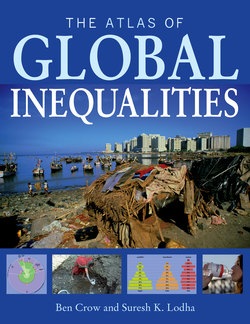Читать книгу The Atlas of Global Inequalities - Ben Crow - Страница 5
На сайте Литреса книга снята с продажи.
ОглавлениеAuthors 1 Acknowledgments 8 Introduction 9 1 Economic Inequalities 14 Income 16 Income inequality both between and within countries has risen dramatically during the process of industrialization. Household Wealth 18 Household wealth is unevenly distributed across the world. A huge proportion is concentrated in the hands of a very few. Consumption 20 Poor households have to spend most of their income on food, with little left for other purposes. Work & Unemployment 22 Differences in livelihoods, remuneration, unemployment, and underemployment create considerable inequalities. Labor Migration 24 Labor migration can help address global inequalities. 2 Power Inequalities 26 International Trade 28 Globally determined commodity prices and high tariffs on imports from poorer nations create barriers to trade equality. Budget Priorities 30 The proportion of GDP that governments spend on the military, healthcare, education, and social security provides one measure of their social priorities. Government Action 32 In response to popular pressure, governments may attempt to reduce inequality through minimum wage laws, progressive taxation, and land reforms. Freedom & Democracy 34 While freedoms and democracy are hard to quantify, even rough measures indicate significant inequalities within and between nations. Incarceration & Execution 36 Rates of imprisonment vary widely around the world, and the use of execution is rare in industrialized countries. 3 Social Inequalities 38 Gender 40 Bias against women is reflected in their unequal political and economic participation and influence, their hours in unpaid work, and in the preference for sons over daughters. Age 42 Age distinctions can create inequalities by excluding age groups and undervaluing their work. Population structures provide impetus for looking beyond national boundaries.
Contents
